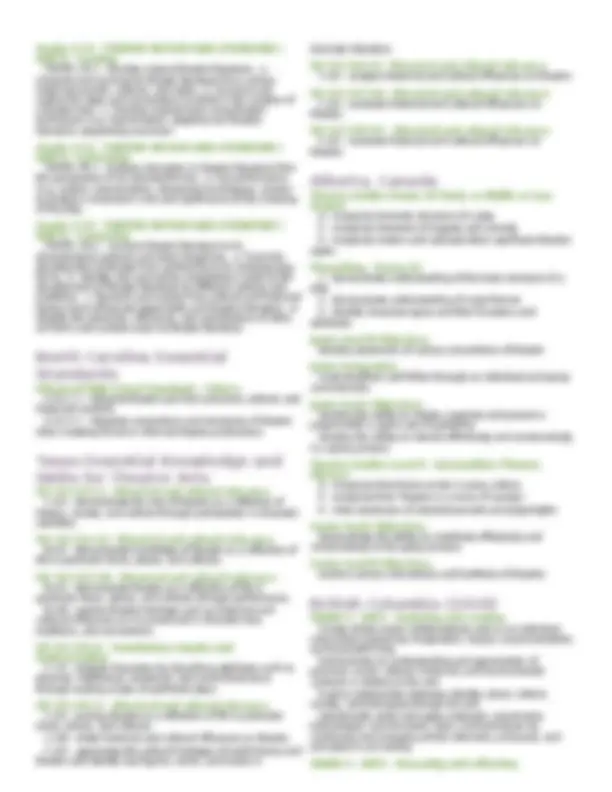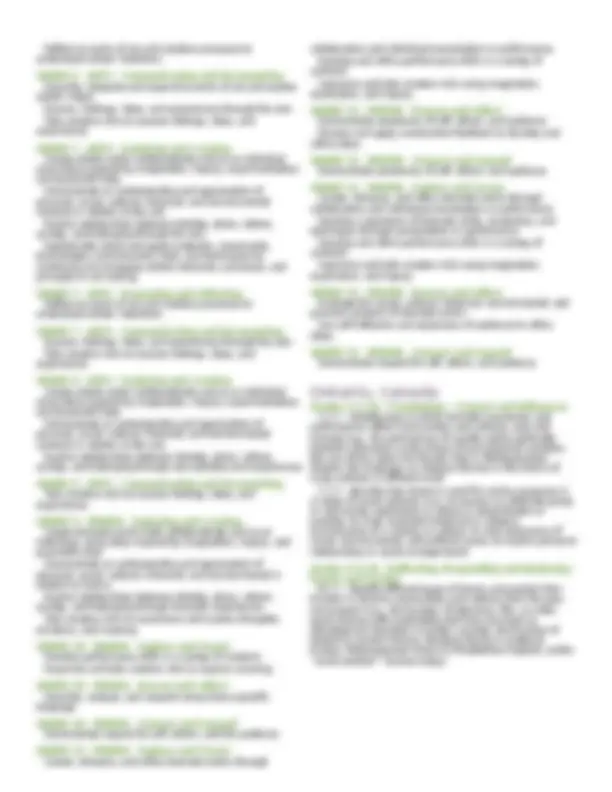




Study with the several resources on Docsity

Earn points by helping other students or get them with a premium plan


Prepare for your exams
Study with the several resources on Docsity

Earn points to download
Earn points by helping other students or get them with a premium plan
Community
Ask the community for help and clear up your study doubts
Discover the best universities in your country according to Docsity users
Free resources
Download our free guides on studying techniques, anxiety management strategies, and thesis advice from Docsity tutors
The Comedy of Manners is a style of comedy that uses satire to highlight the behaviours, actions, fashions, and “manners” of a segment of society.
Typology: Lecture notes
1 / 4

This page cannot be seen from the preview
Don't miss anything!



The Comedy of Manners is a style of comedy that satirizes the behaviour, actions, fashions, and “manners” of a segment of society. Because it has such specific characteristics – from plot to dialogue, to characterization, to costumes – it’s an excellent era for students to learn and apply.
In this unit students are introduced to the style, learn some background, and apply the traits of the comedy of manners. The unit culminates in the creation of a modern scene.
1 - Introduction The Comedy of Manners is a style of comedy that uses satire to highlight the behaviours, actions, fashions, and “manners” of a segment of society. In this lesson students discuss the nature of comedies that make fun of a group of people and the definition of satire. They are taken through a slide deck that introduces the background and style elements of the comedy of manners. Students also complete a Viewing Quiz.
2 - Manners and Codes in the Comedy of Manners The comedy of manners is a style of comedy that uses satire to highlight the behaviours, actions, fashions, and “manners” of a segment of society. Students will explore the element of manners and codes of behaviour in a modern context, and then look at how the element is applied to a scene from The Importance of Being Earnest.
3 - Verbal Comedy in the Comedy of Manners The comedy of manners is a style of comedy that uses satire to highlight the behaviours, actions, fashions, and “manners” of a segment of society. Students will explore aspects of verbal comedy in a modern context and then look at how the element is applied to a scene from The Importance of Being Earnest.
4 - Characters in the Comedy of Manners The Comedy of Manners is a style of comedy that uses satire to highlight the behaviours, actions, fashions, and “manners” of a segment of society. Students will explore characters in the comedy of manners and then create a comedy of manners character profile with one of the characters from The Importance of Being Earnest.
5 - Culminating Assignment In this culminating assignment, students will apply what they have learned throughout this unit to a modern devised scene.
Interpret intent and meaning in artistic work - Grade 6 TH:Re8.1.6.b - Identify cultural perspectives that may influence the evaluation of a drama/theatre work.
Interpret intent and meaning in artistic work - Grade 7 TH:Re8.1.7.b - Describe how cultural perspectives can influence the evaluation of drama/theatre work.
Interpret intent and meaning in artistic work - Grade 8 TH:Re8.1.8.b - Analyze how cultural perspectives influence the evaluation of a drama/theatre work.
Interpret intent and meaning in artistic work - Grade HS Accomplished TH:Re8.1.HSII.b - Apply concepts from a drama/theatre work for personal realization about cultural perspectives and understanding.
Relate artistic ideas and works with societal, cultural, and historical context to deepen understanding - Grade 6 TH:Cn11.2.6.b - Investigate the time period and place of a drama/theatre work to better understand performance and design choices.
Language CCSS.ELA-LITERACY.CCRA.L.1 - Demonstrate command of the conventions of standard English grammar and usage when writing or speaking.
CCSS.ELA-LITERACY.CCRA.L.2 - Demonstrate command of the conventions of standard English capitalization, punctuation, and spelling when writing.
Reading: Literature CCSS.ELA-LITERACY.RL.9-10.1 - Cite strong and thorough textual evidence to support analysis of what the text says explicitly as well as inferences drawn from the text.
Language CCSS.ELA-LITERACY.L.9-10.1 - Demonstrate command of the conventions of standard English grammar and usage when writing or speaking.
CCSS.ELA-LITERACY.L.9-10.2 - Demonstrate command of the conventions of standard English capitalization, punctuation, and spelling when writing.
6.TH:Re8 Interpret intent and meaning in artistic work. 6.TH.Re8.b - Identify cultural contexts that may influence the evaluation of a drama/theatre work.
7.TH:Re8 Interpret intent and meaning in artistic work. 7.TH.Re8.b - Describe how cultural contexts can influence the evaluation of drama/theatre work.
8.TH:Re8 Interpret intent and meaning in artistic work. 8.TH.Re8.b - Analyze how cultural contexts influence the evaluation of a drama/theatre work.
Acc.TH:Re8 Interpret intent and meaning in artistic work. Acc.TH.Re8.b - Apply concepts from a drama/theatre work for personal realization about cultural contexts and understanding.
6.TH:Cn11.2 Relate artistic ideas and works with societal, cultural, and historical context to deepen
understanding. 6.TH:Cn11.2.b - Investigate the time period and place of a drama/theatre work to better understand performance and design choices.
Critical Thinking & Reflection TH.912.C.1.6 - Respond to theatrical works by identifying and interpreting influences of historical, social, or cultural contexts.
Historical & Global Connections TH.912.H.1.1 - Analyze how playwrights' work reflects the cultural and socio-political framework in which it was created. TH.912.H.1.3 - Present a design or perform in the style of a different historical or cultural context to gain appreciation of that time and culture.
Organizational Structure TH.912.O.1.4 - Write an original script or a dramatic adaptation of a literary work to demonstrate knowledge of theatrical conventions. TH.912.O.2.2 - Perform a scene or monologue in a non- traditional way that stays true to its dramatic structure and can be justified within the script.
Skills, Techniques & Processes TH.912.S.2.3 - Demonstrate an understanding of a dramatic work by developing a character analysis for one or more of its major characters and show how the analysis clarifies the character's physical and emotional dimensions.
Grade 6 - Connecting TA6.CN.2 - Examine the role of theatre in a societal, cultural, and historical context., a. Describe the origins of theatre., b. Identify and analyze ways in which theatre influences and reflects the culture of a society., c. Utilize a multi-disciplinary approach to research, create, and support artistic choices., d. Examine the relevance of cultural and historical context.
Grade 7 - Creating TA7.CR.2 - Develop scripts through theatrical techniques., a. Create ideas for stories., b. Analyze the theme and structure of a play., c. Use the dramatic writing process to generate a script., d. Utilize dramatic conventions in the scriptwriting process (e.g. stage directions, dialogue, scenes).
Grade 7 - Connecting TA7.CN.2 - Examine the role of theatre in a societal, cultural, and historical context., a. Examine theatre development throughout history., b. Identify and analyze cultural influences on theatre., c. Utilize multi-disciplinary research skills to obtain cultural and historical information to justify artistic choices (e.g. costuming, make-up, setting of a time period in relation to the play)., d. Draw conclusions about the influence of theatre on society.
Grade 8 - Connecting TA8.CN.2 - Examine the role of theatre in a societal, cultural, and historical context., a. Compare and contrast how theatre evolves through time., b. Examine how culture is defined through theatre and other media., c. Apply advanced research skills to obtain appropriate cultural and historical information to rationalize artistic choices (e.g. costuming, make-up, setting of a time period in relation to the play)., d. Discuss theatre’s role in reflecting the culture of a society.
Reflect on works of art and creative processes to understand artists' intentions
GRADE 6 - ARTS - Communicating and documenting Describe, interpret and respond to works of art and explore artists’ intent
Express, feelings, ideas, and experiences through the arts Take creative risks to express feelings, ideas, and experiences
GRADE 7 - ARTS - Exploring and creating Create artistic works collaboratively and as an individual using ideas inspired by imagination, inquiry, experimentation, and purposeful play
Demonstrate an understanding and appreciation of personal, social, cultural, historical, and environmental contexts in relation to the arts
Explore relationships between identity, place, culture, society, and belonging through the arts
Intentionally select and apply materials, movements, technologies, environments, tools, and techniques by combining and arranging artistic elements, processes, and principles in art making
GRADE 7 - ARTS - Reasoning and reflecting Reflect on works of art and creative processes to understand artists’ intentions
GRADE 7 - ARTS - Communicating and documenting Express, feelings, ideas, and experiences through the arts Take creative risks to express feelings, ideas, and experiences
GRADE 8 - ARTS - Exploring and creating Create artistic works collaboratively and as an individual using ideas inspired by imagination, inquiry, experimentation, and purposeful play
Demonstrate an understanding and appreciation of personal, social, cultural, historical, and environmental contexts in relation to the arts
Explore relationships between identity, place, culture, society, and belonging through arts activities and experiences
GRADE 8 - ARTS - Communicating and documenting Take creative risks to express feelings, ideas, and experiences
GRADE 9 - DRAMA - Exploring and creating Create dramatic works both collaboratively and as an individual, using ideas inspired by imagination, inquiry, and purposeful play
Demonstrate an understanding and appreciation of personal, social, cultural, historical, and environmental in relation to drama
Explore relationships between identity, place, culture, society, and belonging through dramatic experiences
Take creative risks to experience and express thoughts, emotions, and meaning
GRADE 10 - DRAMA - Explore and Create Develop performance skills in a variety of contexts Improvise and take creative risks to express meaning
GRADE 10 - DRAMA - Reason and reflect Describe, analyze, and respond using drama-specific language
GRADE 10 - DRAMA - Connect and expand Demonstrate respect for self, others, and the audience
GRADE 11 - DRAMA - Explore and Create Create, rehearse, and refine dramatic works through
collaborative and individual presentation or performance Develop and refine performance skills in a variety of contexts Improvise and take creative risks using imagination, exploration, and inquiry
GRADE 11 - DRAMA - Reason and reflect Demonstrate awareness of self, others, and audience Receive and apply constructive feedback to develop and refine ideas
GRADE 11 - DRAMA - Connect and expand Demonstrate awareness of self, others, and audience
GRADE 12 - DRAMA - Explore and Create Create, rehearse, and refine dramatic works through collaborative and individual presentation or performance Develop a repertoire of dramatic skills, vocabulary, and techniques through presentation or performance Develop and refine performance skills in a variety of contexts Improvise and take creative risks using imagination, exploration, and inquiry
GRADE 12 - DRAMA - Reason and reflect Evaluate the social, cultural, historical, environmental, and personal contexts of dramatic works Use self-reflection and awareness of audience to refine ideas
GRADE 12 - DRAMA - Connect and expand Demonstrate respect for self, others, and audience
Ontario, Canada Grades 9 & 10 - Foundations - Context and Influences C.2.1 - identify ways in which dramatic expression and performance reflect communities and cultures, past and present (e.g., the prominence of socially and/or politically powerful characters in the drama of pre-industrial societies; the use of boy actors for female roles in Shakespearean theatre; the emphasis on religious themes in the drama of many cultures in different eras) C.2.2 - describe how drama is used for various purposes in a range of social contexts (e.g., to express or celebrate group or community sentiments or values in street theatre or parades; to mark important historical or religious anniversaries of a country or culture; to raise awareness of social, environmental, and political issues; to explore personal relationships or social arrangements)
Grades 9 & 10 - Reflecting, Responding and Analyzing - Drama and Society B.2.1 - identify different types of drama and explain their function in diverse communities and cultures from the past and present (e.g., the function of television, film, or video game dramas with predictable plot lines and stock or stereotypical characters in today’s society; the function of theatre in ancient Greece, liturgical drama in medieval Europe, Shakespearean drama in Elizabethan England, and/or “social problem” dramas today)